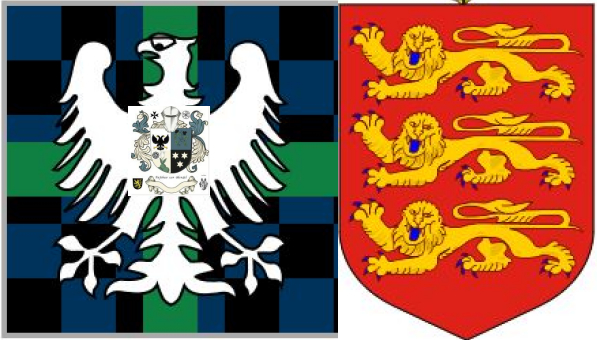


Seigneur de Saint-Sauveur-le-Vicomte - Viscount of the CotentinThe title "Seigneur de Saint-Sauveur-le-Vicomte" (Lord of Saint-Sauveur-le-Vicomte) or the
Viscount of the Cotentin is a noble designation historically associated with the commune of
Saint-Sauveur-le-Vicomte in the Manche department of France. This title was prominent during the medieval period,
notably held by the Néel family, who were influential in the Cotentin region. For instance, Néel II, Vicomte of
Saint-Sauveur, founded the Abbey of Saint-Sauveur-le-Vicomte in the 11th century. Neil de St. Sauveur III (circa 985–after 1066), also known as Nigel III, Viscount of the Cotentin, was a Norman noble and the son of Nigel de St. Sauveur II and Helena. As Viscount of the Cotentin, Neil played a significant role in Norman history, leading a rebellion against Duke William of Normandy in 1047. After his defeat, he was exiled to d’Aubigney in Brittany but later pardoned and reinstated to his estates. Neil owned lands in Guernsey, particularly in the parishes of Torteval and St. Peter of the Wood, which formed a feudal fief tied to the title of Viscount of the Cotentin. This connection is significant because, while the title of Viscount of the Cotentin originates in Normandy, the ability to inherit and maintain noble titles in that region was abolished after the French Revolution. In contrast, Guernsey, a Crown Dependency, retained its feudal traditions and structure, including the legal framework for noble titles associated with land ownership. Thus, Neil’s land in Guernsey preserved the ancient rights tied to the title of Viscount, making the fief a rare and enduring link to the medieval feudal nobility. Neil also fought alongside William the Conqueror at the Battle of Hastings in 1066, a pivotal event in the Norman Conquest of England. His contributions are recognized in the Battle Abbey Rolls, which list him as a commander. The Norman victory secured William’s control of England, and Neil, as one of the elite nobles supporting the conquest, was rewarded with land and lordships. Neil’s family legacy continued through his marriage to Adela d’Ecu, with their descendants, including William D’Aubigny, playing prominent roles in English history. The family name evolved over centuries, becoming “Abney” by 1500. Today, the ancient fief in Guernsey associated with Neil de St. Sauveur III provides a tangible and legal connection to his noble title, uniquely preserving the heritage of the Viscount of the Cotentin in a way that is no longer possible in mainland France. Over the centuries, the title passed through various noble families, including the Harcourt family. Geoffroy
d'Harcourt, known as "the Lame," held the title in the 14th century and played a significant role during the early
stages of the Hundred Years' War. However, with the abolition of feudalism during the French Revolution in the late 18th century, noble titles and the associated privileges were officially abolished in France. Consequently, the title of Seigneur de Saint-Sauveur-le-Vicomte ceased to exist in any official capacity. While some noble titles have been retained in a ceremonial or historical context, they no longer carry legal recognition or authority. As of today, there is no officially recognized Seigneur de Saint-Sauveur-le-Vicomte. The commune operates under the standard administrative structures of the French Republic, with elected officials managing local governance. At one time, the Vicomte of St. Sauveur was the owner of the feudal Fief of Thomas Blondel, whereas the Seigneur of the Fief of Blondel still accepts the feudal title of Viscount of the Contentin. The title of Viscount (Vicomte) of the Cotentin, historically associated with the Saint-Sauveur family in Normandy, France, became obsolete following the French Revolution in the late 18th century, which abolished the French nobility's privileges and titles. Since then, the title has not been officially recognized or reinstated. While descendants of the original noble families may exist, there is no current, legally recognized claimant to the title of Viscount of the Cotentin.
|
Seigneur de la Fief of Blondel Lord Baron Mentz of Fief Blondel Geurnsey Crown Dependency Seigneur Fief of Blondel George Mentz Lord Baron of Fiefdom Blondel Freiherr of Fief Thomas Blondel Feudal Lord of Baronnie - Noble Fief Barony Friherre > Seigneur de Saint-Sauveur Seigneurs and Dames Travel Research Lord Paramount Feudal Barons The Seigneur Order Patron George Mentz Charter of Liberties Deed & Title Fief Blondel Islands Viking Kingdom Fief Worship Fiefs of the Islands ECS Extended Continental Shelf Styles and Dignities Territorial Waters Blondel Privy Seal Fief Bouvees of Fief Thomas Blondel Guernsey Court of Chief Pleas Fief Court Arms Motto Flower Fief de l'Eperon La Genouinne Kingdom of West Francia Fief DuQuemin Bouvée Phlipot Pain Bouvée Torquetil Bouvée Bourgeon Bailiwick of Ennerdale Channel Island History Fief Direct from the Crown A Funny Think Happened On the Way to the Fief Guernsey Bailiwick of Guernsey - Crown Dependency Confederation des Iles Anglo-Normandes Sovereignty Papal Bull Research Links Norse Normandy Order of the Genet Order of the Genet Order of the Star Est. 1022 Knights of theThistle of Bourbon Count of Anjou Fief Rights Blondel and King Richard Press Carnival Manorial Incidents Appointments of Seigneurs Store Portelet Beach Roquaine Bay Neustrasia Columbier Dovecote Fief Blondel Merchandise Fief Blondel Beaches Islands Foreshore Events Fiefs For Sale Sold Lords of Normandy Fief Coin Viscounts de Contentin Fief Blondel Map Feudal Guernsey Titles Board of Trustees The Feudal System Hereditaments Chancellor Flag & Arms Fief Videos Guernsey Castle Sark Contact Advowson Site Map Disclaimer Freiherr Livres de perchage Lord Baron Longford Income Tax Guernsey Valliscaulian Order Saint Benedict of the Celestines Society of Divine Compassion Dictionary Count of Mortain Seigneur de Saint-Sauveur Seigneur of Fief Ansquetil Top Success Books Datuk Seri George Mentz Order St. Benedict OSB Celestines Order of the Iron Crown Order of the White Falcon Colonel Mentz Order Red Eagle Order St. Louis Order Holy Ghost Order of Saint Anthony Order of the Black Swan Order of St Columban Order of the Iron Helmet Livonian Brothers of the Sword Fief treizième and Direct from Crown Valuation Fief Blondel Prince of Annaly Teffia
Feudal Lord of the Fief Blondel of the Nordic Channel Islands Guernsey Est.
1179
Feudalherr - Fief Blondel von der Nordischen Insel Guernsey Est. 1179
New York Gazette - Magazine of Wall Street -
George Mentz -
George Mentz - Aspen Commission - Mentz Arms
Counselor George Mentz Esq. - Seigneur Feif BlondelBaron Annaly Baron Moyashel Grants to Delvin About Longford Styles and Dignities The Seigneur Court Barons Fiefs of the Islands Longford Map The Island Lords Market & Fair Fief Worship Channel Island History Fief Blondel Lord Baron Longford Fief Rights Fief Blondel Merchandise Events Blondel and King Richard Fief Coin Feudal Guernsey Titles The Feudal System Flag & Arms Castle Site Map Disclaimer Blondel Myth DictionaryMentz Scholarship Program 101 Million Donation - Order of the Genet Knighthood |





George Mentz Education -
Commissioner George Mentz
-
https://finance.yahoo.com/news/commissioner-george-mentz-clinches-influencer-180000705.html
-
George Mentz News -
George Mentz Net Worth - George Mentz Noble Tilte -
George Mentz -
George Mentz Trump Commissioner -
George Mentz Freiherren Count Baron -
George Mentz Global Economic Forum -
George Mentz Donates Millions